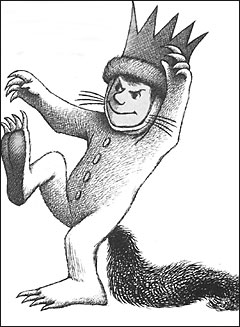Wild Things Art Lesson

Grade Level-1st grade
Georgia QCC and Performance Standards-
Topic: Artistic Skills and Knowledge: Creating, Performing, Producing
Standard: Uses imagination and immediate environment, including family, home, and surroundings, as sources for ideas.
Topic: Language Arts
Standard: Identifies parts of speech including adverbs and adjectives.
ELA1W1: The student begins to demonstrate competency in the writing process.
ELA1LSV1: The student uses oral and visual strategies to communicate.
Specific Objective: The students in this first grade class will create an imaginative drawing of a monster after listening to the story of Where the Wild Things Are with 100% accuracy.
Materials: Where the Wild Things Are by Maurice Sendak, construction paper, crayons, dry-erase board and marker, pencils, wiggly eyes, glue, example of wild thing
Procedures:
Motivation/Attention Getter: Show students the “Wild Thing” puppet and ask them if they know what it is.
Tie to Previous Learning: Students have previously used their imaginations to write stories, now they will be using their imagination to create an artistic image.
Teaching Sequence: First, I will introduce the story to the students. Then, I will explain that I will read the story to them and then they will create their own “wild things”. Next, I will instruct the students to listen closely to the story so they can listen for words that describe the wild things. I will then read the story. I will provide directions to the students about their imaginative drawings. I will explain that they can use any of the materials listed above. I will also explain that they are to write one sentence about their wild thing. They can write its name or what it likes to eat or do for fun. I will provide the students with and example of someone’s artwork. Last, I will tell the students to return to their seats to begin their drawings.
Closure: If time permits, I will call the students to come up to the front of the room and show their drawings to the class and read their sentence aloud.
Transition: I will tell the students to clean their work space and prepare for their Math lesson.
Lesson Adaptation: Individual Assistance will be provided as needed.
Technology Integration: None Applicable
Evaluation: The students’ drawings will be evaluated to make sure they are complete and include one sentence describing their drawing.
Connections: Students can use their imagination to create anything.





